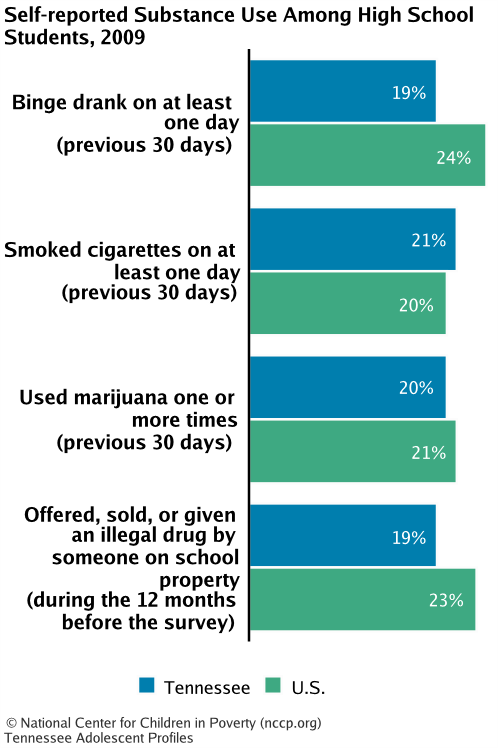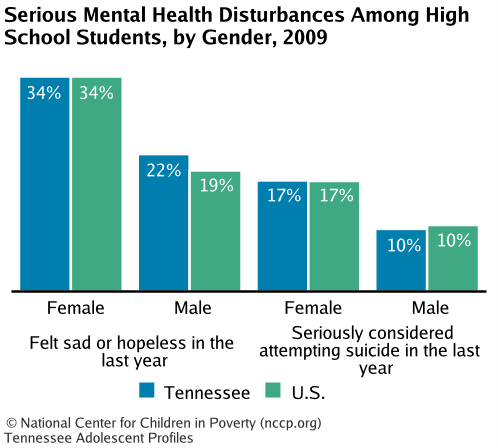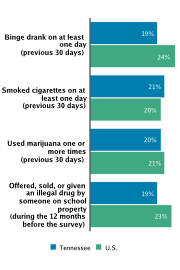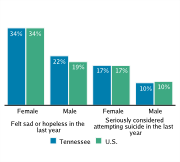| Health | Mental Health | Violence and Injury Prevention |
State Choices to Promote Access


Promotion, Prevention, and Early Intervention
- Have a public school health education curriculum that requires drug/alcohol prevention education [2006]2
- Have legislation or board of education policy that explicitly establishes and applies social and emotional learning standards [2010]3
Services in Schools
- Counseling for emotional or behavioral disorders [2006]4
- Crisis intervention for personal problems [2006]4
- Suicide prevention services [2006]5
Law and Legislation
- Allow minors to consent to outpatient mental health care [2010]6
- Allow minors to consent to care for drug or alcohol abuse [2010]7
State Choices to Promote Quality
Workforce Development
- Provide funding or staff development on emotional and mental health to health education teachers [2006]9
Self-reported mental health needs of youth in juvenile justice residential placement (not state-specific)[2003]10
68% Easily upset
61% Lost temper easily
61% Felt angry a lot
51% Had nervous or worried feelings keep you from doing things you want to do?
52% Felt lonely too much of the time
70% Had something very bad or terrifying happen to you
67% Seen someone severely injured or killed (in person)
Data Notes and Sources
Last Updated: June 1, 2011
These state profiles are part of the Improving the Odds for Adolescents project, which is supported by a generous grant from The Atlantic Philanthropies. Contact us with questions or to update your state profile.
- Centers for Disease Control and Prevention, Youth Risk Behavior Surveillance System (YRBSS). 2009. High School Youth Risk Behavior Survey, 2009. Accessed Aug. 10, 2010, from apps.nccd.cdc.gov/YouthOnline/App/Default.aspx.
- Centers for Disease Control and Prevention, State-Level School Health Policies and Practices. A State-by-State Summary from the School Health Policies and Programs Study 2006. Table 1.5. Accessed July 29, 2010, from www.cdc.gov/HealthyYouth/SHPPS/2006/summaries/pdf/State_Level_Summaries_SHPPS2006.pdf.
Centers for Disease Control and Prevention, State-Level School Health Policies and Practices. A State-by-State Summary from the School Health Policies and Programs Study 2006. Table 1.6. Accessed July 29, 2010, from www.cdc.gov/HealthyYouth/SHPPS/2006/summaries/pdf/State_Level_Summaries_SHPPS2006.pdf. - Data not available.
Palmer, Kara. 2010. A Study of Statewide Social and Emotional Learning Policy and Practices: Prepared for the Raikes Foundation. - Centers for Disease Control and Prevention. State-Level School Health Policies and Practices: A State-by-State Summary from the School Health Policies and Programs Study 2006. Table 3.2.2. Accessed Mar. 5, 2010, from www.cdc.gov/HealthyYouth/SHPPS/2006/summaries/pdf/State_Level_Summaries_SHPPS2006.pdf.
- Centers for Disease Control and Prevention, State-Level School Health Policies and Practices. A State-by-State Summary from the School Health Policies and Programs Study 2006. Table 3.3. Accessed July 29, 2010, from www.cdc.gov/HealthyYouth/SHPPS/2006/summaries/pdf/State_Level_Summaries_SHPPS2006.pdf.
- Only if 16 or older and with serious emotional disturbance or mental illness.
Many states generally allow emancipated minors, married minors, pregnant minors, minor parents, or other subgroups to consent for their own health care.
English, Abigail; Bass, Lindsay; Boyle, Alison Dame; Eshragh, Felicia. 2010. State Minor Consent Laws: A Summary, 3rd Edition. Center for Adolescent Health and the Law. - Many states generally allow emancipated minors, married minors, pregnant minors, minor parents, or other subgroups to consent for their own health care.
English, Abigail; Bass, Lindsay; Boyle, Alison Dame; Eshragh, Felicia. 2010. State Minor Consent Laws: A Summary, 3rd Edition. Center for Adolescent Health and the Law. - Centers for Disease Control and Prevention. State-Level School Health Policies and Practices: A State-by-State Summary from the School Health Policies and Programs Study 2006. Table 4.5. Accessed Mar. 5, 2010, from www.cdc.gov/HealthyYouth/SHPPS/2006/summaries/pdf/State_Level_Summaries_SHPPS2006.pdf.
- Centers for Disease Control and Prevention. State-Level School Health Policies and Practices: A State-by-State Summary from the School Health Policies and Programs Study 2006. Table 1.14. Accessed Mar. 5, 2010, from www.cdc.gov/HealthyYouth/SHPPS/2006/summaries/pdf/State_Level_Summaries_SHPPS2006.pdf.
- Sedlak, Andrea J.; McPherson, Carla S. 2010. Youth's Needs and Services: Findings from the Survey of Youth in Residential Placement, OJJDP Juvenile Justice Bulletin. Accessed July 19, 2010, from www.ncjrs.gov/pdffiles1/ojjdp/227728.pdf.


